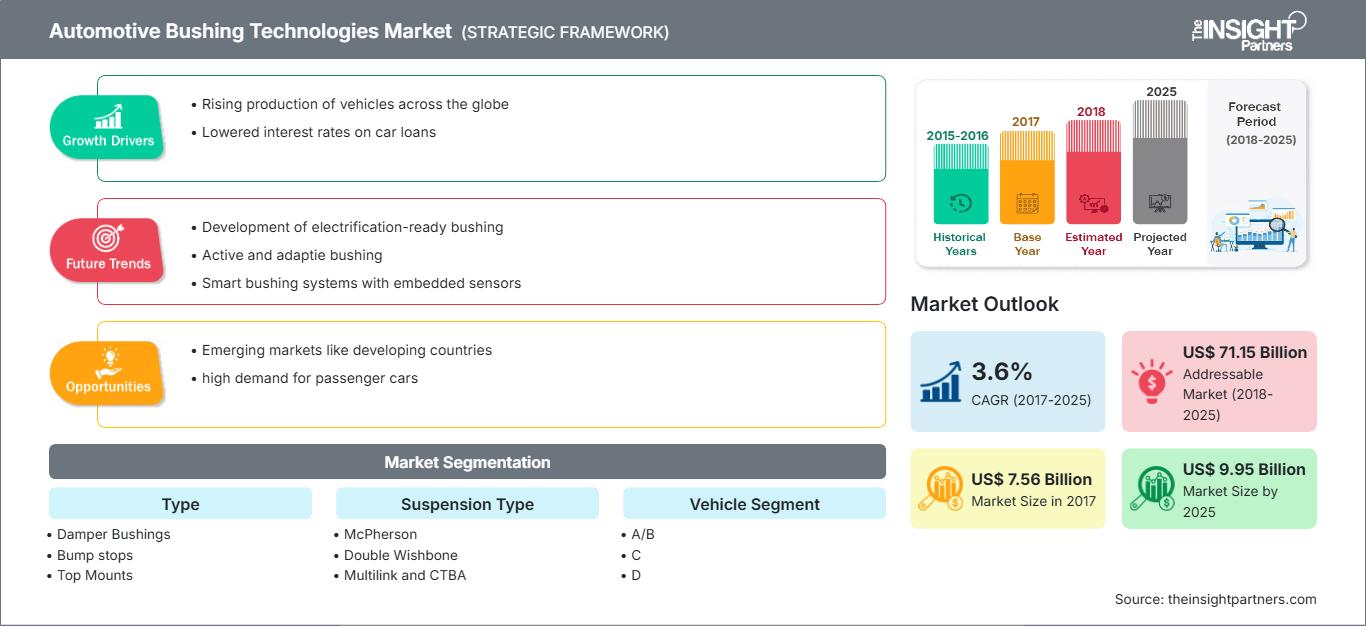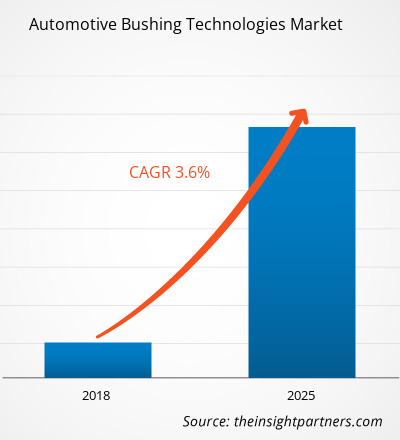2017 年汽车衬套技术市场价值为 75.606 亿美元,预计到 2025 年将达到 99.472 亿美元;预计 2017 年至 2025 年的复合年增长率为 3.6%。
乘用车由众多金属部件组成,这些部件确保汽车在平坦和略有岩石的道路上正常平稳地运行。悬架系统在确保车内乘客平稳行驶方面起着至关重要的作用。这些固体悬架部件相互连接,并在车辆行驶时传输能量。衬套是通常由橡胶或聚氨酯材料制成的小部件,可作为固体金属悬架部件传输的噪音和振动的隔离器。这些衬套可以减少振动和噪音,从而确保乘客平稳舒适的乘坐体验。衬套的功能包括隔振、缓冲以及减少车辆内固体金属部件之间的摩擦。通常,衬套应用于汽车内部任何需要金属接头和支架的地方。交流发电机衬套、控制臂衬套、减震器支架、稳定杆连杆、变速箱换挡杆、电机支架和副车架支架是乘用车中最常用的衬套。根据衬套的使用寿命,更换衬套也成为车主的一项重要任务。
汽车衬套应用于汽车内部连接两个固体金属部件的接头处。衬套用于缓冲这两个固体部件之间的运动,并能够吸收冲击和振动。它们可以减少车辆行驶过程中不同部件之间传递的能量。乘用车由众多部件组成,例如发动机、变速箱、悬架系统、控制臂、防滚杆,这些部件在车辆行驶时都是噪音和振动的来源。这些噪音和振动是固体金属部件之间能量传递的结果,会给车内乘客带来困扰。
这些噪音和振动会干扰驾驶员,并给车内乘客带来不愉快的乘车体验。这些干扰和刺激还可能导致交通事故,因为它们会分散驾驶员的注意力。发达的道路基础设施使驾驶更加平稳,然而,崎岖不平的道路会导致金属部件之间产生大量运动。因此,对更平稳驾驶的需求催生了对有助于隔离金属部件引起的噪音和振动的产品的需求。汽车衬套可以显著减少向乘客传递的振动和噪音,因为它们可以衰减和吸收这些能量。衬套制造商必须满足一定的噪声振动强度标准,才能为车内乘客提供舒适、平稳的驾驶体验。汽车衬套被认为是乘用车中最容易被忽视的悬架部件。然而,随着人们对驾驶燃油效率的日益重视以及对更平顺驾乘体验的需求激增,乘用车衬套产品的需求也随之健康增长。衬套作为一种用于隔离振动和噪音,并通过阻尼减少传递给车内乘员的能量的产品,在现代社会中变得至关重要。如今,汽车制造商非常关注满足噪声振动与声振粗糙度 (NVH) 标准,因为车辆的每个运动部件都会产生某种噪声。因此,车辆会在行驶过程中产生噪声的位置安装许多衬套。这些衬套大多安装在车辆悬架系统附近或周围。市场上出售的衬套类型取决于各种参数。确定合适衬套的关键参数包括衬套的成本、衬套的耐用性和使用寿命、车内乘员在道路上的感受性能、衬套的性能、NVH 等级以及安装和维护的复杂性。
自定义此报告以满足您的要求
您将免费获得任何报告的定制,包括本报告的部分内容,或国家级分析、Excel 数据包,以及为初创企业和大学提供超值优惠和折扣
汽车衬套技术市场: 战略洞察

-
获取本报告的主要市场趋势。这个免费样本将包括数据分析,从市场趋势到估计和预测。
全球范围内,城市化趋势呈指数级增长。因此,居住在城市的人口的平均可支配收入也在增加,这让他们能够改善生活方式。因此,全球乘用车的运营数量正在增加,进一步创造了对乘用车生产的需求,以满足不断增长的需求。自 2010 年以来,后经济衰退时期汽车产量稳步增长。世界发达经济体和发展中经济体在后经济衰退时期对新乘用车的需求稳步上升。此外,降低贷款利率也有利于汽车行业急需的增长。在过去的 7 到 8 年里,乘用车产量一直保持着接近 2% 的同比增长。
基于类型的市场洞察
全球汽车衬套技术市场根据类型细分为;减震器衬套、保险杠挡块、顶部支座、悬架臂衬套和 PT 支座。PT 支座细分市场进一步细分为发动机衬套、滚杆衬套和变速箱衬套。这些不同类型的衬套集成到汽车不同部件中,位于两个金属部件的连接接口处。由于衬套用于缓冲两个金属部件之间的运动,因此最终有助于吸收驾驶员和乘客在车轮后感受到的冲击和振动。
基于悬架类型的市场洞察
全球汽车衬套技术市场根据悬架类型细分为:麦弗逊式、双叉臂式、多连杆式、耦合扭力梁式、铣削、切割和加工以及 PT 支座。悬架系统负责车辆在行驶过程中的安全,尤其是在崎岖多石的地形上。仅靠轮胎充足的气压、座椅的缓冲以及少数部件的填充不足以抵抗车道上遇到的冲击。因此,悬架系统在缓冲和吸收冲击方面的作用变得至关重要。悬架系统为车辆乘员提供稳定性和乘坐舒适性。
基于车辆的市场洞察
欧洲汽车制造商已经建立了基于车辆质量和车辆面积参数的乘用车分类标准。该分类在欧洲被广泛使用。随着全球乘用车数量的增加,汽车制造商发现按照欧洲汽车细分市场对汽车进行分类非常方便,可以简化某些车型。除了简化分类之外,该方案还减少了类别数量。乘用车分为 A/B 级、C 级、D 级、E 级、F 级和 SUV 级。
产品开发是公司扩展其产品组合的常用策略。 Vibracoustic GmbH、BOGE GmbH、Continental AG、Tenneco Inc. 和 Federal Mogul LLC 等公司是全球汽车衬套技术市场的主要参与者,它们正在实施扩大客户群和获取显著份额的战略,从而维护其品牌声誉。近期的一些关键发展包括:
- 2018 年,该公司的液压衬套产品采用集成流体系统,可提供约 1,230 N 至 3,000 N 的出色负载阻力。这些液压衬套可用作商用车辆的发动机和驾驶室支架。
- 2018 年,Tenneco 与 Freightliner 达成协议,为其 Cascadia 8 级拖拉机供应控制扭矩衬套。这些控制扭矩衬套具有低扭转脱离和高锥形刚度。
汽车衬套技术市场区域洞察
The Insight Partners 的分析师已详尽阐述了预测期内影响汽车衬套技术市场的区域趋势和因素。本节还讨论了北美、欧洲、亚太地区、中东和非洲以及南美和中美洲的汽车衬套技术市场细分和地域分布。
汽车衬套技术市场报告范围
| 报告属性 | 细节 |
|---|---|
| 市场规模 2017 | US$ 7.56 Billion |
| 市场规模 2025 | US$ 9.95 Billion |
| 全球复合年增长率 (2017 - 2025) | 3.6% |
| 历史数据 | 2015-2016 |
| 预测期 | 2018-2025 |
| 涵盖的领域 |
By 类型
|
| 覆盖地区和国家 |
北美
|
| 市场领导者和主要公司简介 |
|
汽车衬套技术市场参与者密度:了解其对业务动态的影响
汽车衬套技术市场正在快速增长,这得益于终端用户需求的不断增长,而这些需求的驱动因素包括消费者偏好的不断变化、技术进步以及对产品优势的认知度不断提高。随着需求的增长,企业正在扩展产品线,不断创新以满足消费者需求,并抓住新兴趋势,从而进一步推动市场增长。

- 获取 汽车衬套技术市场 主要参与者概述
汽车衬套技术市场细分:
按类型
- 减震器衬套
- 减震器挡块
- 顶部支架
- 悬挂臂衬套
- 副车架衬套
- PT 支架
按悬挂类型
- 麦弗逊式
- 双叉臂式
- 多连杆式和 CTBA 式
按车辆细分
- A/B、C、D、E、F
- SUV(A、B、C、D 和 E)
公司简介
- Vibracoustic GmbH
- BOGE GmbH
- Continental AG
- Tenneco Inc.
- Federal Mogul LLC
- Cooper Standard Holdings Inc.
- 印度现代理工科技
- Nolathane、Paulstra SNC
- Sumiriko AVS 德国有限公司
- 历史分析(2 年)、基准年、预测(7 年)及复合年增长率
- PEST和SWOT分析
- 市场规模、价值/数量 - 全球、区域、国家
- 行业和竞争格局
- Excel 数据集
近期报告
客户评价
购买理由
- 明智的决策
- 了解市场动态
- 竞争分析
- 客户洞察
- 市场预测
- 风险规避
- 战略规划
- 投资论证
- 识别新兴市场
- 优化营销策略
- 提升运营效率
- 顺应监管趋势






















 获取免费样品 - 汽车衬套技术市场
获取免费样品 - 汽车衬套技术市场